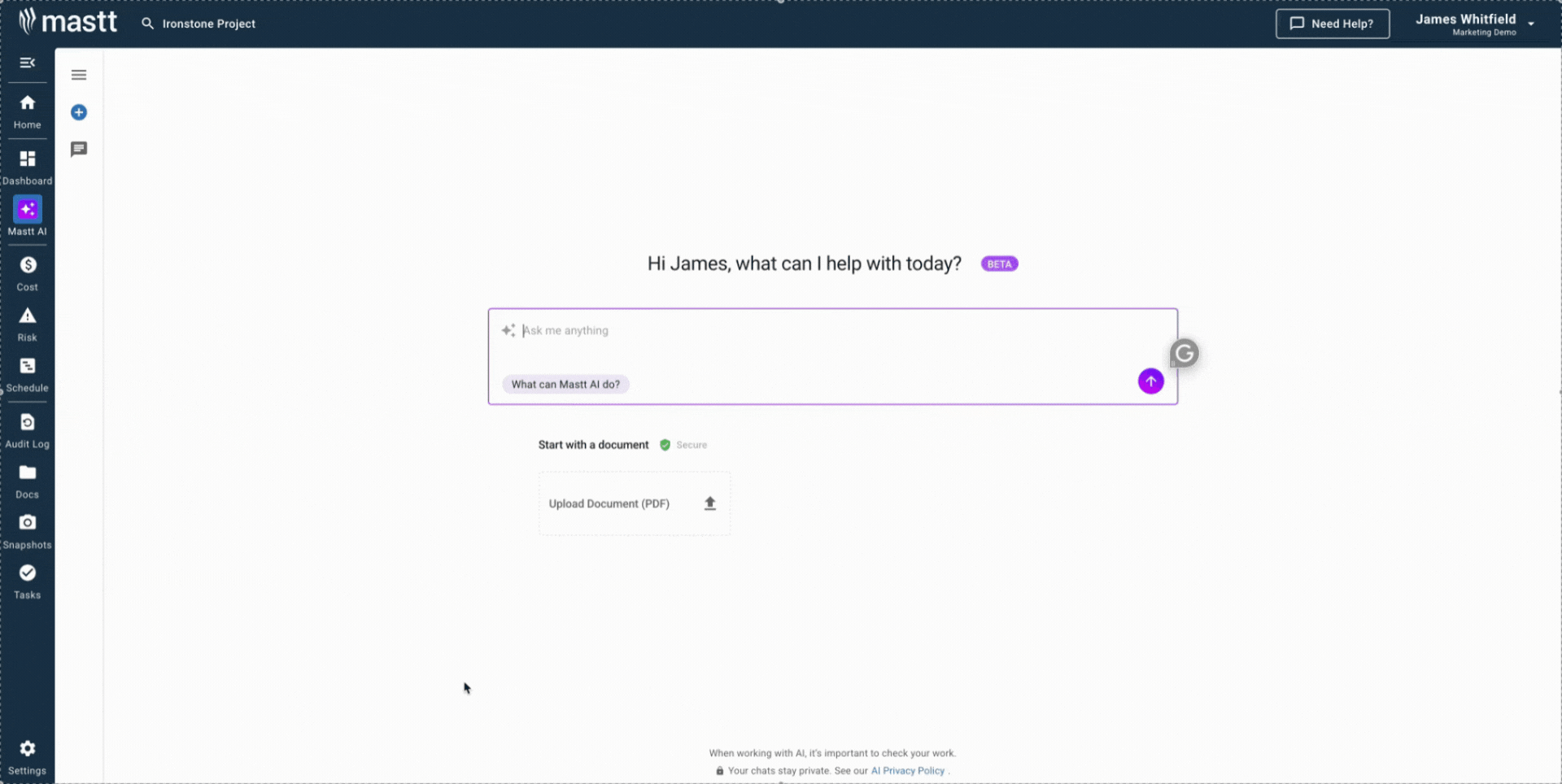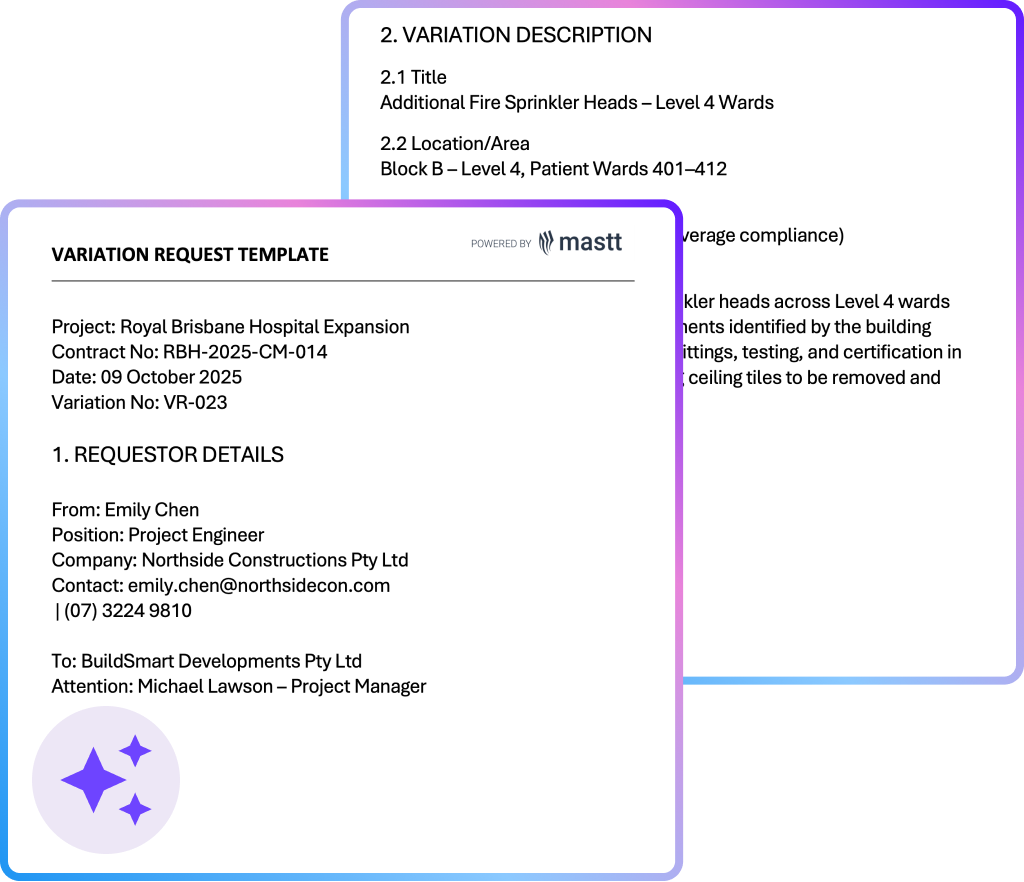What is a Variation Request Template?
A variation request template is a structured document used to propose changes to a project’s approved scope, design, cost, or schedule. It provides a consistent method for recording and communicating construction variations, ensuring that every adjustment is reviewed and approved before work proceeds.
Using a variation order request template keeps project teams aligned, reduces misunderstandings, and ensures each modification is justified and contractually compliant. Whether managing small design tweaks or major scope changes, a standardised template supports transparency and control throughout the approval process.
What’s Included in a Construction Variation Request Template
A variation request template for construction includes all key sections required to capture, justify, and assess proposed changes to the works. Each field ensures the variation can be evaluated accurately in line with contract procedures and valuation principles.
Here’s what’s typically included in a complete variation request form:
- Project and contract details: Includes project title, contract number, site address, and principal or client details to clearly identify the affected contract package.
- Variation reference number: A sequential identifier (e.g., VR-001) used to track requests in the variation register and link them to future variation orders or payment certificates.
- Description of varied works: A detailed summary of the change, including the original scope and proposed modification, supported by relevant drawings, specifications, or RFIs.
- Reason for variation: Explains the cause, such as design development, latent conditions, client instruction, or statutory compliance requirements.
- Cost breakdown and valuation: Provides itemised rates or lump sums using the schedule of rates, daywork rates, or bill of quantities (BOQ).
- Time impact assessment: Notes any extension of time (EOT) request and quantifies potential delay to the programme or critical path.
- Supporting documentation: Includes drawings, specifications, quotations, method statements, or site records used in assessing the variation.
- Approval and certification: Space for signatures from the superintendent, contract administrator, or employer’s agent to formally record assessment and approval.
💡 Pro Tip: Always cross-reference your variation request with the relevant clause in your contract (for example, clause 36 in AS 4000 or clause 5.6 in JCT D&B) to avoid delays in approval or disputes over entitlement.
Why Use a Template for Variation Requests
Using a variation request template standardises how changes to the works are documented and assessed. It helps teams document variation details accurately and comply with contract requirements.
Key reasons to use a template include:
- Consistency across projects: Standardised variation requests help maintain uniform reporting, making it easier for project teams to assess proposals.
- Compliance with contract procedures: Most contracts require written notice or quotation before a variation can be approved. A structured form helps demonstrate compliance with these clauses.
- Improved accuracy in valuation: A template ensures all necessary details, like cost build-ups, schedule of rates, and daywork calculations, are captured for accurate valuation and certification.
- Better communication between parties: Clear documentation helps avoid disputes by aligning expectations between the principal, contractor, and consultant teams before the varied works are executed.
- Traceable audit records: Every variation request form becomes part of the permanent project record, supporting future progress claims, payment certificates, and final account reconciliations.
- Faster approval cycles: Templates reduce rework and missing information, allowing the superintendent or cost consultant to process approvals more efficiently.
Always maintain a variation register alongside your template to track submission dates, superintendent responses, and approved values. This will help you stay audit-ready and aligned with progress claims.
Who Should Use Variation Request Templates
A variation request should be used by anyone involved in managing contract changes, approvals, or cost assessments on a construction project. It ensures all parties communicate variations clearly, maintain proper records, and follow the procedures required under their contract.
Typical users include:
✅ Contractors and Head Contractors: Prepare and submit formal requests when instructed to vary the works or respond to site directions.
✅ Project Managers: Review variation impacts on cost, time, and programme before forwarding for assessment.
✅ Superintendents or Contract Administrators: Evaluate requests, issue directions, and certify approved variations.
✅ Principals or Clients: Approve or reject variations based on cost, risk, and project priorities.
✅ Quantity Surveyors or Cost Consultants: Verify cost build-ups and ensure valuations align with contract provisions.
✅ Architects or Engineers: Confirm design changes or issue site instructions that trigger variation requests.
✅ Subcontractors: Submit variation proposals that align with head contract requirements and approvals.
💡Pro Tip: Encourage all consultants and contractors to use the same format for variation requests and variation orders to streamline approval workflows and avoid missed or duplicated variations.
How to Use a Project Variation Request Template
To use a variation request template, start by identifying the event or instruction that triggered the change. Then, describe the varied works and attach supporting documents.
Follow these steps to use a variation request template effectively:
- Identify the trigger: Record the source of the change, such as a site instruction (SI), RFI response, design change, or client instruction.
- Define the varied works: Describe the affected scope precisely, referencing drawings, specifications, and locations on site.
- Assemble evidence: Attach RFIs, drawings, BOQ extracts, quotations/proposals, method statements, and any relevant site records or photos.
- Build the cost: Prepare an itemised valuation using the schedule of rates, daywork rates, or lump sums, and state the adjustment to the contract sum, noting any provisional sums or PC items.
- Assess time impact: Complete a time impact assessment, quantify any EOT days, explain effects on the critical path, and indicate any change to the date for practical completion.
- Submit for assessment: Send the completed form to the superintendent or contract administrator within the notice period, referencing the relevant contract clause.
- Track approval and certification: Log the request in the variation register, monitor status to approval/VO, and link approved values to progress claims and payment certificates.
Avoid commencing varied works until written approval or a variation order is issued, unless the contract expressly allows urgent works, and record any direction in writing immediately.
Create Accurate Variation Requests with Mastt AI
Mastt AI makes it faster and easier to create professional variation request templates that align with your project’s contract terms and documentation standards. Instead of starting from scratch, you can generate structured, compliant templates in Word or Excel, ready for superintendent review and client approval.
Here’s what you can do with Mastt AI:
⚡ Create variation templates in seconds: Generate ready-to-use forms that include project details, varied works, valuation, time impact, and approval sections.
📂 Refine existing documents: Upload your current forms or PDFs, and Mastt AI will extract and organise the information into a clear, editable format.
📑 Export in multiple formats: Download your completed document in Word or Excel, ready for review, certification, or record keeping.
Mastt AI draws from real-world construction knowledge to align your templates with industry frameworks, ensuring every form captures the right information for cost valuation and contract compliance.
Here’s how to get started with Mastt AI:
- Describe what you need: Type a prompt such as “create a variation request template for AS 4000 contract”.
- Customise with AI: Adjust sections for valuation, EOT, or superintendent approval to match your project’s requirements.
- Export and share: Download your variation request form as a Word or Excel file, ready for submission or inclusion in your variation register.
With Mastt AI, every template remains private and secure within your workspace, giving you full control over project data and document formatting.
👉 Explore more tips in our Help Center and start creating professional variation request templates with Mastt AI today.

When to Use a Project Variation Request Template
A project variation form should be used whenever a change to the works may affect project cost, scope, or time. Here are common situations where a variation request is required:
- Design changes or development: Revised drawings or specifications issued by the architect or engineer that alter the original scope of work.
- Client instructions: Additional works, omissions, or substitutions directed by the principal that modify agreed deliverables.
- Unforeseen site conditions: Discovery of latent conditions such as rock, contamination, or restricted access that impact construction activities.
- Compliance or regulatory updates: Adjustments needed to meet new statutory, safety, or building code requirements.
- Value engineering proposals: Cost-saving or efficiency measures proposed by the contractor that need approval before implementation.
- Superintendent or contract administrator directions: Site instructions or directions that vary must be recorded formally to support later assessment and approval.
💡Pro Tip: Keep variation requests logged against their corresponding site instructions and valuation records to make future certification and reporting more efficient.
Common Problems with Variation Request Templates in Word or Excel
Free variation request templates in Word or Excel can be useful for small projects, but they often lack the structure and accuracy needed for formal contract administration. Many of these templates are generic and fail to capture critical information.
Typical challenges include:
⚠️ Missing contract alignment: Most free downloadable variation request templates in Word or Docs don’t align with clauses from contracts like AS 4000, JCT, or NEC.
⚠️ Limited data tracking: A variation request template in Excel or spreadsheets usually operates as a standalone file with no link to a live variation register or cost module.
⚠️ Formatting and version issues: Variations stored in separate Excel sheets or PDFs are prone to inconsistent formatting, especially when multiple team members update or submit different versions for approval.
⚠️ Incomplete sections: Many free templates overlook important elements such as EOT implications, valuation methods, or links to progress claims, leaving gaps in the project record.
⚠️ Security and storage risks: Sharing Word or Excel templates over email or saving them locally increases the chance of losing critical data or overwriting approved versions.
While a free variation request template in Excel or Word can serve as a starting point, it often requires heavy manual adjustments to meet contract standards and reporting needs.
Save Hours on Variation Requests with Mastt AI
Creating and managing variation requests becomes faster and easier with Mastt AI. Instead of building forms manually in Word or Excel, you can generate a complete, instantly formatted, structured, and tailored variation request template.
Each AI-generated document stays private in your secure workspace, ensuring your variation records remain consistent, compliant, and audit-ready.
👉 Explore more ways to create professional variation requests with Mastt AI today.









